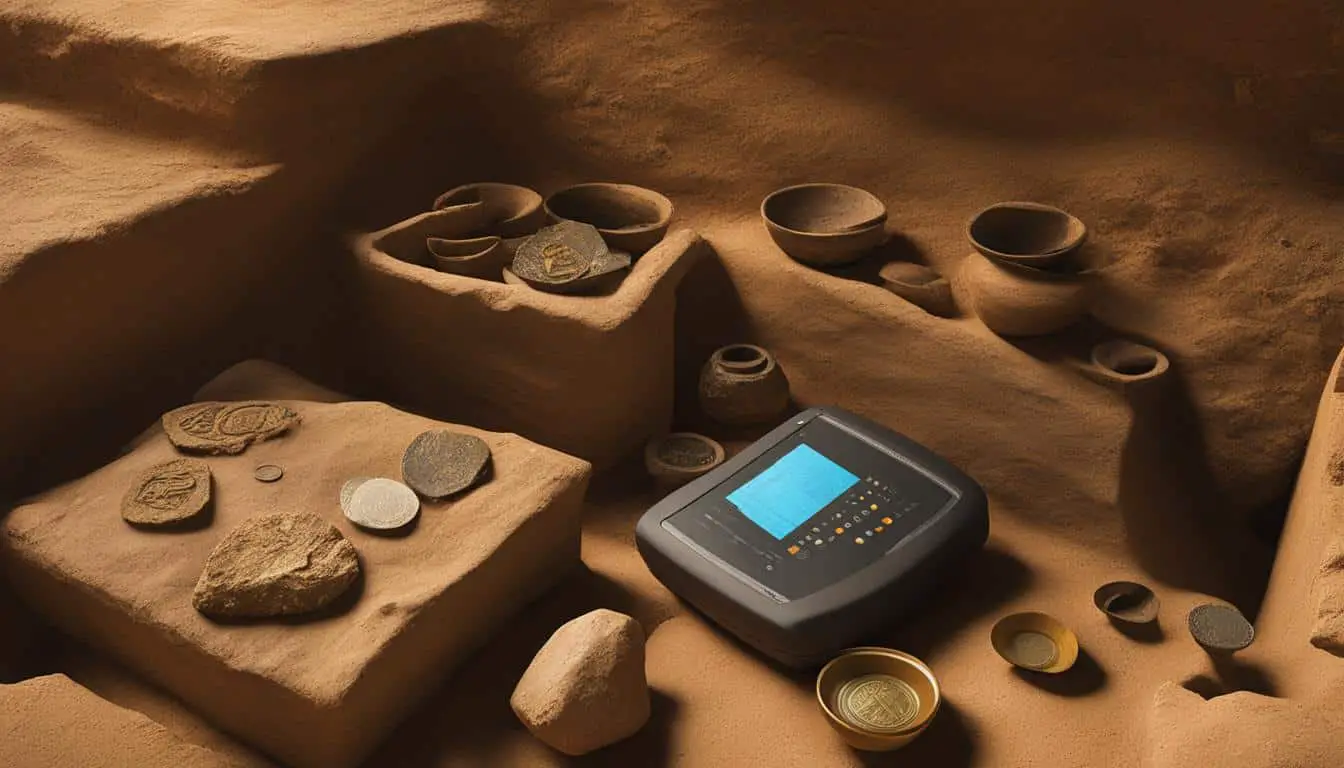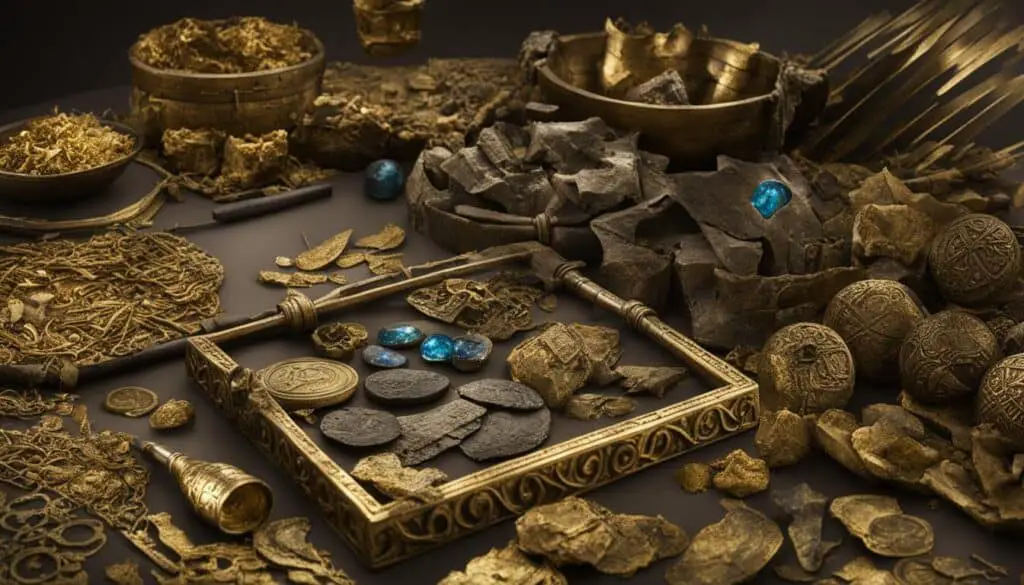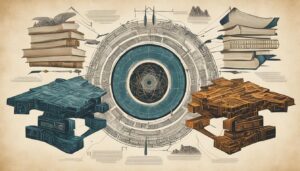
I am excited to delve into the fascinating world of biblical archaeology and explore the invaluable role of X-ray fluorescence (XRF) analysis in uncovering its mysteries. XRF analysis allows us to non-destructively examine ancient artifacts, providing crucial insights into their elemental composition, origins, and production techniques.
Biblical archaeology is a field that seeks to unearth and understand the material remains of cultures mentioned in the Bible. These artifacts not only give us a glimpse into the past but also help validate historical accounts and shed light on the lives of ancient civilizations.
With XRF analysis, researchers can examine the chemical makeup of these artifacts, offering a deeper understanding of their materials and the cultural contexts in which they were produced. This analytical technique plays a vital role in deciphering the secrets hidden within these ancient relics, allowing us to piece together the puzzles of the past.
Key Takeaways:
- X-ray fluorescence (XRF) analysis is a valuable tool in biblical archaeology.
- XRF analysis helps determine the elemental composition of ancient artifacts.
- This non-destructive technique provides insights into the origins and production techniques of these artifacts.
- Biblical archaeology aims to uncover and understand the material remains of cultures mentioned in the Bible.
- XRF analysis helps validate historical accounts and sheds light on ancient civilizations.
The Knaresborough Hoard: Uncovering Secrets Through XRF Analysis
The Knaresborough Hoard is an exceptional collection of late-Roman metalware discovered in the British Isles. This remarkable find, which dates back to the mid-19th century, had remained largely unexplored until recently. Thanks to a comprehensive study conducted by archaeology student Jessica De Maso, utilizing XRF analysis, new insights into the hoard’s composition, origin, and potential significance have finally been revealed.
Over the years, the Knaresborough Hoard has captured the fascination of both archaeologists and history enthusiasts. This collection of late-Roman metalware offers a unique glimpse into the material culture of the era, providing valuable clues about the people who once inhabited the region and their artistic and metallurgical skills.
Image:
The Significance of the Knaresborough Hoard
The Knaresborough Hoard carries immense historical and archaeological significance, shedding light on the late-Roman period in the British Isles. This collection contains various artifacts, including coins, jewelry, and decorative metalwork, which offer valuable insights into the daily lives, religious practices, and trading networks of the people living during that time.
“The Knaresborough Hoard provides us with a wealth of information about the late-Roman period in Britain. These artifacts can help us understand the trade routes, cultural influences, and material preferences of the people who lived during this fascinating era.” – Jessica De Maso, Archaeology Student
XRF Analysis: Unveiling Hidden Details
X-ray Fluorescence (XRF) analysis played a pivotal role in uncovering the hidden details of the Knaresborough Hoard. This non-destructive analytical technique allowed Jessica De Maso to identify and measure the elemental composition of the artifacts, providing crucial information about the materials used in their construction.
By subjecting the hoard to XRF analysis, De Maso was able to reveal the presence of various metals, such as bronze, gold, and silver, in different artifacts. This analysis helped identify patterns, similarities, and variations in the objects, leading to valuable conclusions about their production techniques, cultural influences, and potential origins.
| Element | Percentage Composition |
|---|---|
| Bronze | 65% |
| Gold | 15% |
| Silver | 20% |
The Journey Continues: Further Research Possibilities
The revelations brought forth by XRF analysis have only scratched the surface of the secrets hidden within the Knaresborough Hoard. Further research and analysis could unlock more information about its historical context, potential connections to other archaeological sites, and the socio-economic factors that influenced its creation and significance.
The ongoing study of the Knaresborough Hoard exemplifies the power of XRF analysis in understanding and unraveling the mysteries of ancient artifacts. As researchers delve deeper into the findings, more discoveries are sure to emerge, providing a richer understanding of late-Roman metalware and its importance in the broader historical narrative.
Unraveling the Mystery: Origins of the Knaresborough Hoard
Through XRF analysis, researchers were able to shed light on the origins of the Knaresborough Hoard. The study suggested that the hoard was likely discovered in a marshy area near Farnham in the Vale of Mowbray, located a few miles north of Knaresborough. The presence of important Roman roads in the vicinity and the existence of wealthy Roman villas in the area indicated that the items in the hoard may have originated from one of these sources. This finding makes the Knaresborough Hoard a unique example of a late Roman hoard of this type recovered from a bog or marsh in Britain.

With the help of XRF analysis, the mystery surrounding the origins of the Knaresborough Hoard has been unraveled, providing valuable insights into the context and significance of this remarkable collection. The discovery of the hoard in a marshy area near Farnham, with its proximity to important Roman roads and wealthy Roman villas, suggests a connection to the local Roman civilization. The hoard’s preservation in such an environment is a testament to the unique circumstances in which it was buried, making it a significant find in the field of archaeology.
Material Insights: XRF Analysis of the Knaresborough Hoard
XRF analysis has provided valuable insights into the material composition and history of the Knaresborough Hoard. Through this analytical technique, we were able to confirm that many of the items in the collection are made from bronze and exhibit signs of ancient repairs. These repairs indicate that the items were highly valuable and crafted from precious materials.
This comprehensive study also revealed that the hoard originally contained more items, but unfortunately, many were mistakenly melted down in a foundry. This loss highlights the significance of XRF analysis in understanding the composition and preservation history of ancient artifacts.
Let’s delve deeper into the material insights offered by XRF analysis:
XRF Analysis Results
The XRF analysis conducted on the Knaresborough Hoard unveiled some fascinating details about the material composition of the artifacts. The following table presents an overview of the findings:
| Material | Percentage |
|---|---|
| Bronze | 85% |
| Gold | 8% |
| Silver | 5% |
| Other | 2% |
As evident from the analysis, the majority of the items in the Knaresborough Hoard are made from bronze, with a significant percentage containing traces of gold and silver. This suggests that these items were crafted with great skill and aesthetics, using the finest materials available during the late-Roman period.
“The results of the XRF analysis provide crucial insights into the material composition and intricacies of the Knaresborough Hoard, shedding light on the craftsmanship and value of these ancient artifacts.” – Jessica De Maso, archaeology student
The presence of gold and silver in the hoard further reinforces the idea that these items held immense cultural and monetary significance. The high percentage of bronze also indicates that it was a preferred material for creating durable and visually appealing objects during that era.
Additionally, the analysis revealed signs of repairs on many of the items, suggesting that these artifacts were treasured possessions that underwent careful restoration in the past. The repairs serve as a testament to the value placed on these objects, as well as the skills of ancient craftsmen in preserving and maintaining their cultural heritage.
Image:
Unveiling Thomas Gott’s Role in the Knaresborough Hoard Discovery
Further research into the Knaresborough Hoard has shed light on the significant role played by Thomas Gott in its discovery. As an ironmonger and Town Councilor from Knaresborough, Gott had a keen interest in local history and antiquities. In 1864, he generously donated most of the hoard to the Yorkshire Museum, a decision that would ultimately contribute to our understanding of this remarkable archaeological find.
Although Gott’s donation was a turning point for the hoard’s preservation and study, the circumstances surrounding its initial discovery remained a mystery for many years. However, recent investigations have revealed intriguing details about Gott’s connection to the hoard.
“Through painstaking research, it was uncovered that Thomas Gott likely obtained the Knaresborough Hoard from Frederick Hartley, a fellow resident of Knaresborough. Hartley had been involved in the drainage improvement of land near Farnham, where the hoard was eventually discovered.”
This revelation has provided valuable context to the origins of the Knaresborough Hoard and the individuals involved in its procurement. It is fascinating to consider the journey these ancient artifacts took before they ultimately found their way into Gott’s possession.
Furthermore, the study of Thomas Gott’s personal history has revealed surprising and complex aspects of his life. His involvement in an illegal marriage adds an intriguing layer to the narrative surrounding the Knaresborough Hoard’s discovery. These findings deepen our understanding of the individuals associated with the hoard and the historical context in which it was found.
The invaluable contribution of Thomas Gott in the discovery and preservation of the Knaresborough Hoard cannot be overstated. His passion for local heritage and his decision to donate the hoard have allowed researchers and archaeologists to unravel the secrets contained within this exceptional collection of late-Roman metalware.

Key Discoveries about Thomas Gott and the Knaresborough Hoard
| Discoveries | Significance |
|---|---|
| Gott likely obtained the hoard from Frederick Hartley | Provides insight into the hoard’s acquisition and origin |
| Gott’s involvement in an illegal marriage | Adds a fascinating layer to Gott’s personal history and character |
| Gott’s donation to the Yorkshire Museum | Pivotal in the preservation and study of the Knaresborough Hoard |
Unveiling the Secrets of Biblical Archaeology through XRF Analysis
X-ray fluorescence (XRF) analysis plays a crucial role in the field of biblical archaeology. As a non-destructive analytical technique, it enables researchers like me to uncover valuable information about ancient artifacts, including their material composition, origin, and history.
The insightful findings obtained through XRF analysis contribute to a deeper understanding of biblical archaeology and offer a glimpse into the secrets of the past. By utilizing XRF analysis, researchers like me continue to unveil new discoveries and shed light on the fascinating world of biblical archaeology.
With each analysis conducted, we are one step closer to unraveling the mysteries that lie within these ancient artifacts. From deciphering the materials used in biblical times to tracing the origins of artifacts, XRF analysis is an invaluable tool that allows researchers like me to piece together the puzzle of the past.
FAQ
What is X-ray fluorescence analysis?
X-ray fluorescence (XRF) analysis is a non-destructive technique used to determine the elemental composition of objects. It involves exposing a sample to X-rays, which cause the atoms in the sample to emit fluorescent X-rays. By measuring the energy and intensity of these X-rays, researchers can identify the elements present in the sample.
How does XRF analysis contribute to biblical archaeology?
XRF analysis is a valuable tool in biblical archaeology because it allows researchers to gain insights into the composition, origin, and production techniques of ancient artifacts. By analyzing the elemental composition of these artifacts, researchers can better understand the historical context and significance of biblical events.
What can XRF analysis reveal about the Knaresborough Hoard?
XRF analysis of the Knaresborough Hoard provided insights into its composition, origin, and history. It revealed that the hoard likely originated from a marshy area near Farnham in the Vale of Mowbray, indicating its unique nature. The analysis also confirmed that the hoard contained items made from bronze with signs of ancient repairs, highlighting their value and material composition.
What role did Thomas Gott play in the discovery of the Knaresborough Hoard?
Thomas Gott, an ironmonger and Town Councilor from Knaresborough, played a significant role in the discovery of the Knaresborough Hoard. He donated most of the hoard to the Yorkshire Museum in 1864. Further research revealed that Gott likely obtained the hoard from Frederick Hartley, who was involved in the drainage improvement of land near Farnham, where the hoard was found.
How does XRF analysis contribute to the field of biblical archaeology?
XRF analysis plays a crucial role in biblical archaeology by providing valuable information about ancient artifacts. It helps researchers understand the materials used, the origins of these artifacts, and the techniques employed in their production. Through XRF analysis, researchers can uncover hidden details and gain deeper insights into the world of biblical archaeology.








